Picture this: you’re walking along a beach at midnight, and suddenly the waves around your feet explode into electric blue light, as if each step triggers a cosmic fireworks display beneath the water. It’s not your imagination playing tricks on you. This breathtaking phenomenon isn’t some mystical occurrence from a fantasy novel, but one of nature’s most stunning displays—ocean bioluminescence. From the shores of California to the coasts of the Maldives, millions of people have witnessed this otherworldly spectacle that transforms ordinary seawater into what looks like liquid starlight.
What Creates This Magical Blue Glow

Bioluminescence is caused by tiny organisms that drift in the ocean called Lingulodinium polyedra. These microscopic creatures are actually a type of marine algae, often called dinoflagellates, that possess a remarkable superpower—they can create their own light through a chemical reaction inside their bodies. Think of them as nature’s own living flashlights, each one smaller than the width of a human hair. This chemical reaction requires a chemical called luciferin, as well as oxygen, the right conditions, and an enzyme called luciferase. When these ingredients come together, they produce a cold light that doesn’t generate heat, unlike a traditional flame or bulb. The process is so efficient that nearly 100% of the energy gets converted to light, making it far more effective than any human-made lighting system.
The Secret Chemistry Behind the Light Show

Bioluminescent dinoflagellates produce light using a luciferin-luciferase reaction. The magic happens when the enzyme luciferase acts like a key that unlocks the chemical energy stored in luciferin. The interaction of the luciferase with oxidized (oxygen-added) luciferin creates a byproduct, called oxyluciferin. More importantly, the chemical reaction creates light. It’s like a microscopic factory where oxygen serves as the fuel, luciferin as the raw material, and luciferase as the machinery that assembles everything together. Therefore, in order to lower the pH, voltage-gated channels in the scintillon membrane are opened to allow the entry of protons from a vacuole possessing an action potential produced from a mechanical stimulation. This complex process happens faster than you can blink your eye—literally in about 20 milliseconds.
Why Blue Light Rules the Ocean

Most of the bioluminescence produced in the ocean is in the form of blue-green light. This is because these colors are shorter wavelengths of light, which can travel through (and thus be seen) in both shallow and deep water. Blue light acts like the ocean’s preferred currency because it travels farther than any other color underwater. Light traveling from the sun of longer wavelengths—such as red light—doesn’t reach the deep sea. Moreover, because it’s not present, many deep-water animals have lost the ability to see it altogether. It’s nature’s way of being practical—why waste energy producing red or yellow light when blue is the only color that really matters in the underwater world? That is probably because blue light can travel farthest in water since water absorbs the other colors in the spectrum more quickly. This explains why most marine bioluminescence appears blue to our eyes, even though some organisms can produce different colors.
When the Ocean Turns Electric

It’s when nighttime rolls around, and they get physically disturbed — like from a breaking wave, a boat, a dolphin or a surfer — that they unleash their glow. The light only appears when something moves through the water, creating turbulence that triggers the organisms’ defense mechanism. Blue flashes occur when waves or predators move around dinoflagellates. These movements lead to a chemical reaction that produces light. Picture millions of tiny biological burglar alarms going off simultaneously—each disturbance activates the light-producing machinery inside these microscopic creatures. Since their glow is controlled by circadian rhythms, the light only occurs at night. During the day, these organisms are busy photosynthesizing like plants, gathering energy from sunlight to power their nighttime light show.
The Red Tide Connection

Their strong swimming abilities are the reason they are able to take over the coastal ecosystem, turning the water red during the day, hence the term red tide, and making it glow at night. These aren’t just random events—bioluminescent displays often coincide with what scientists call red tides, which occur when dinoflagellates multiply rapidly into massive blooms. These blooms are called red tides as they appear red brown in color during the daytime. The same organisms responsible for the magical blue glow at night create an entirely different visual during the day, painting the water in rusty red-brown hues. Dr. Drew Lucas, an associate professor at Scripps Institution of Oceanography at UC San Diego who has researched the plankton species and their bioluminescent blooms, told NBC 7. In fact, they swim so well for their size that Lucas has referred to them as the Michael Phelps of the plankton world. This swimming prowess allows them to dominate their environment during bloom events.
Nature’s Living Flashlights in the Deep

While relatively rare on land, bioluminescence is very common in the ocean, at least in the pelagic zone (the water column), where 80 percent of the animals that live between 200 and 1,000 meters (656 and 3,280 feet) depth are bioluminescent. The deeper you go in the ocean, the more common bioluminescence becomes, until it’s practically universal among marine life. In fact, an estimated 90 percent of the animals that live below 500 m in the oceans pelagic zone are bioluminescent. It’s like entering an alien world where almost every creature carries its own lighting system. In the deep sea, bioluminescence is extremely common, and because the deep sea is so vast, bioluminescence may be the most common form of communication on the planet! From tiny jellyfish to massive squids, these animals use light to talk to each other in the eternal darkness of the deep ocean.
The Swimming Champions Creating the Show

Calling them the “Michael Phelps of the plankton world,” Lucas said the tiny organisms — “smaller than the width of a human hair” — swim to the ocean surface to use sunlight for energy and then swim down to the ocean bed at night to source vital nutrients to grow and reproduce. These microscopic athletes perform a daily vertical migration that’s like running a marathon in miniature. They’re like plants in the sense that they photosynthesize, but they’re unlike most plants in the fact that they move around a bunch. They can swim. During the day, they rise to the surface to catch sunlight for photosynthesis, then at night they dive deep to gather nutrients from the ocean floor. This allows the plankton to grow in number giving rise to the blue waves that people love. Their incredible swimming ability is what separates them from other marine algae and makes their massive blooms possible.
Defense Mechanisms in Microscopic Form
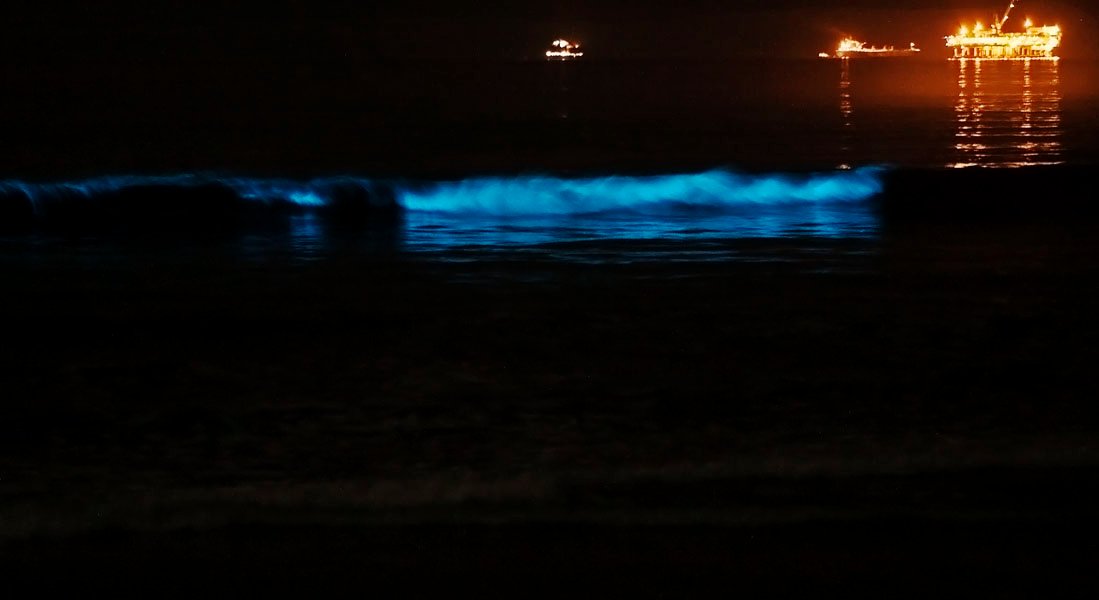
Dinoflagellates specifically flash their bright blues to protect themselves from their predators, copepods. The blue light serves as a sophisticated alarm system, designed to startle and confuse anything that might want to eat them. When they’re attacked, some of them can flash the light like a burglar alarm to get the attention of an even bigger creature like a shark to scare off the attacker. The glow is believed to be a defensive mechanism that startles predators and makes them vulnerable to creatures of higher trophic levels. It’s like calling for backup in the animal kingdom—the flash of light might attract a larger predator that could chase away the immediate threat. Living organisms use bioluminescence to protect themselves, to attract mates, to communicate, and to camouflage. Think of this like using glow sticks to protect yourself or to make friends or to warn someone. Each flash is a message in the ocean’s complex communication network.
The Unpredictable Nature of Blue Waves
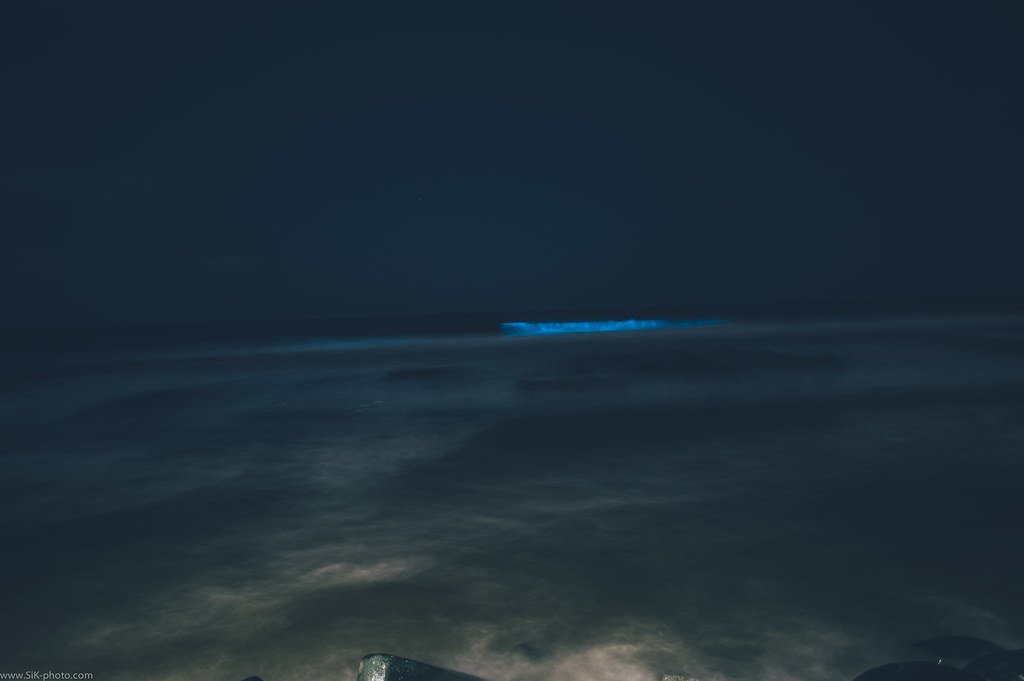
The beautiful, electric blue glowing water can be tough to track in nature – usually lighting up far past bedtime and elusively moving from beach to beach with ocean currents. Other times, the bioluminescent waves don’t show up at all, leaving hopeful people standing on the beach waiting all night in anticipation, only to leave disappointed. Predicting when and where these magical displays will occur remains one of nature’s biggest mysteries. Nevertheless, even though it is impossible to predict when they will occur or how long they will last, scientists confirm that they’ve been going on for a while, at least since 1900. We know that natural events like changes in water and wind patterns and storms can lead to a drop in bioluminescence levels. The best way to predict whether you are gonna see bioluminescence at the beach is to check your social media. Photographers and citizen scientists have become the unofficial early warning system for these spectacular events.
When Conditions Are Just Right
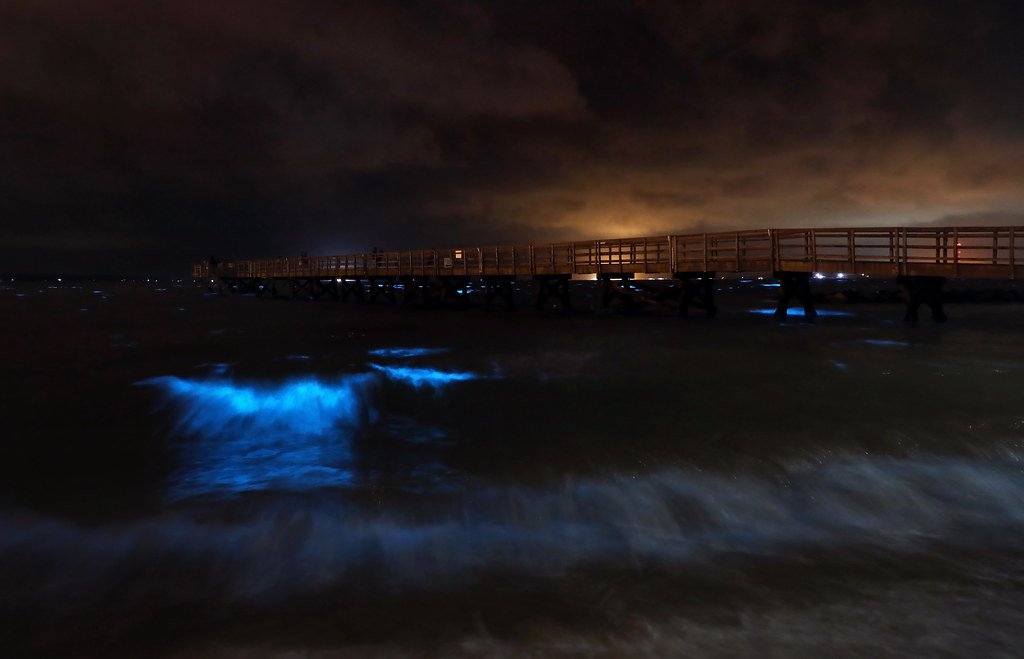
The late rains, coupled with the high summer temperatures, created a “layered situation in the ocean” where the surface and the deep are separated by a strong temperature change, creating the optimum temperatures for these organisms to thrive. Perfect bioluminescent conditions require a delicate balance of factors working together like a natural recipe. Temperature, nutrient levels, water chemistry, and even weather patterns all play crucial roles in creating the right environment for dinoflagellate blooms. The natural phenomenon can happen almost any time of the year but more often in spring to early fall. In fact, global warming and climate change are affecting how frequently these blooms occur. Scientists are still studying how environmental changes might be altering the frequency and intensity of these natural light shows.
The Duration Mystery
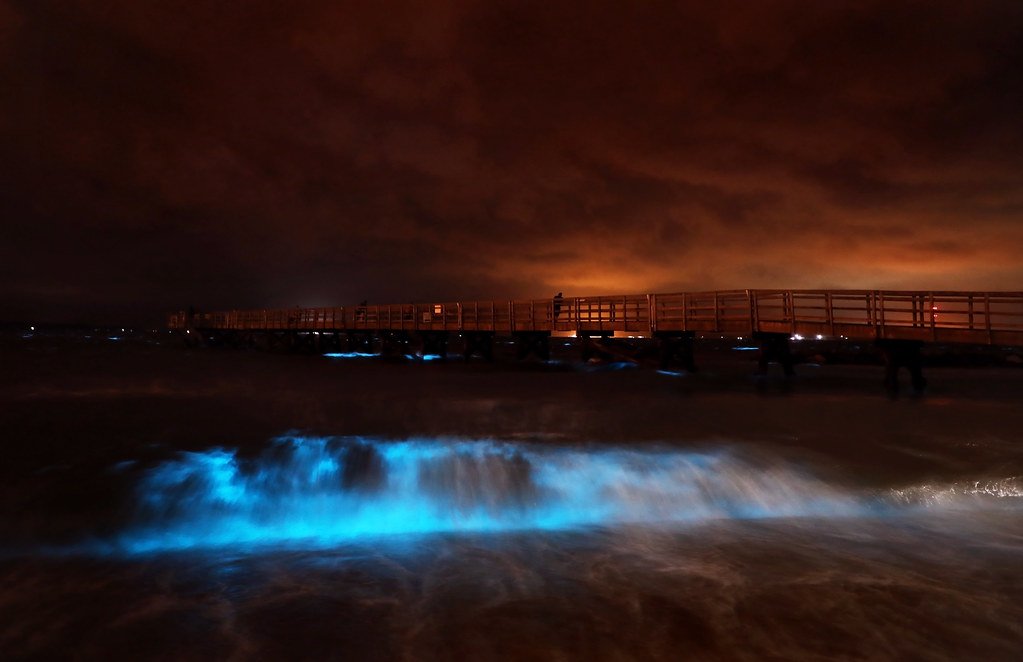
The amount of time the red tides that cause bioluminescence lasts varies, but Lucas says they typically stick around for a couple of weeks. In 2020, the red tide was around for almost two months. Sometimes, it’s only a night or two that is really bioluminescing at the beach. The unpredictability extends to how long these displays will last once they appear. Some events burn out quickly like a brief firework show, while others can persist for weeks, giving lucky observers multiple chances to witness the phenomenon. They last as long as the chemicals causing bioluminescence last. It is okay if you miss the display one night, you can always come back the next night, when the chemicals are fully stocked. The organisms need time to recharge their light-producing chemicals after each display, which is why the intensity can vary from night to night.
Hotspots Around the World
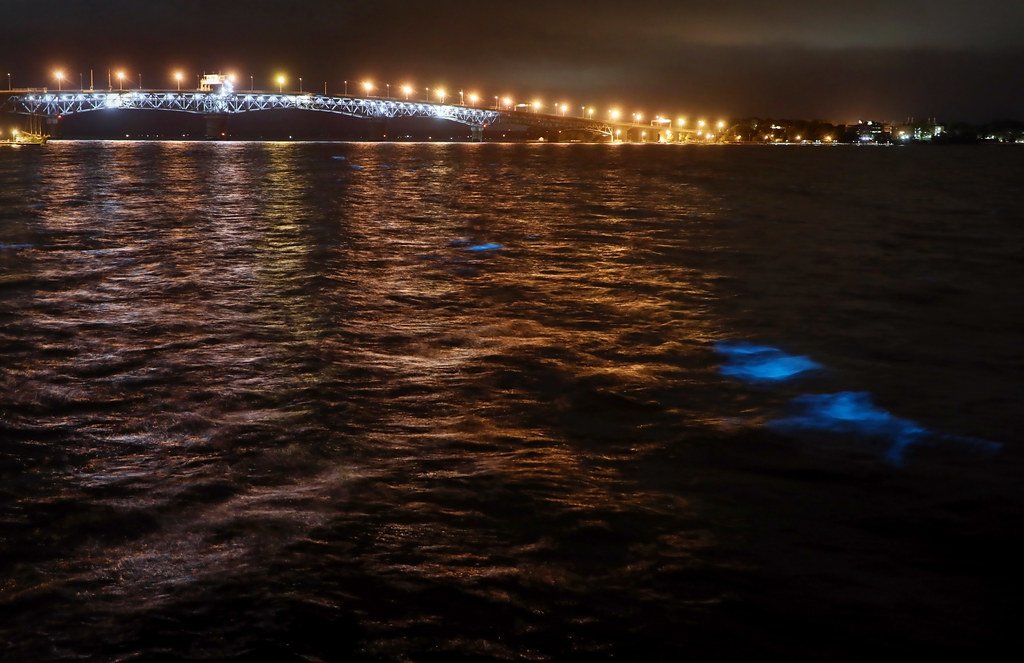
This sparkling phosphorescent luminosity is a frequent event on the beaches of California, Florida, Australia, Jamaica, Vietnam, Puerto Rico, the United Kingdom, and the Maldives. Certain locations around the globe have become famous for their reliable bioluminescent displays. Since then, he has witnessed the glow at several beaches, including Torrey Pines State Beach, North Ponto Beach and Carlsbad State Beach. In Southern California, beaches from San Diego to Los Angeles have become hotspots for bioluminescence seekers. This phenomenon can be seen in Parksville Qualicum Beach a few times a year during summer. The phytoplankton can typically be seen in July and August. Stroll along the water at Rathtrevor Beach for a chance to spot the blue glow in the crashing waves. Each location has its own seasonal patterns and optimal viewing conditions.
The Human Experience

It’s just something that fills a lot of emotions in people, it is so otherworldly when you’re seeing it in person. Witnessing bioluminescence creates an almost spiritual connection with nature that’s hard to describe in words. We were just elated because it was just magical. Many people describe the experience as life-changing, like discovering a hidden superpower that the ocean has kept secret. Out at sea, it’s a unique experience seeing the boat’s wake light up and there have been descriptions of pelicans diving into the ocean with their splash turning neon and dolphins frolicking to light up the dark sea. The phenomenon becomes even more spectacular when marine animals interact with the glowing water, creating trails of light as they move through the bioluminescent field. Snorkeling is great fun as the organisms will light up as you approach giving the effect of traveling at light speed through the stars.
Safety and Swimming Concerns

It is my understanding that, in general, people tolerate swimming in the red tide just fine,” said Lucas, who claims he has swam and surfed in it. In a typical scenario, the bioluminescent red tide is not harmful to human health or even the ecosystem. While many bioluminescent events are harmless to humans, not all glowing water is safe for swimming. Some bioluminescent algae produce toxins that are harmful to marine wildlife, humans, and anything that comes in contact with them, so it may not be safe to touch the algae or swim in bioluminescent water. You can visit sea shores that have bioluminescent algae, but it’s best to avoid contact with the algae and watch the glow from a safe distance. During red tides, marine animals like fish or shrimp that eat algae also become poisonous as dinoflagellate toxins accumulate in their bodies. If you come in contact with the algae or eat these toxic sea creatures, you may have side effects like bowel problems or food poisoning. The safest approach is to admire the beauty from the shoreline rather than diving in.
Tips for Bioluminescence Seekers

For the best viewing choose a moonless night and dark area away from city lights. Successfully spotting bioluminescence requires patience and the right conditions—darkness is absolutely essential. Go to a very dark place on the beach such as the shoreline so that your eyes acclimatized to seeing hints of light in the dark · Plan to be there for over an hour because Nguyen says, “You’re not going to see anything exciting, unless you’re there for that amount of time, because some of the waves are very faint, and some of them you can’t miss. Patrick Coyne, a Torrance photographer who documents bioluminescence across Southern California, chasing it from the South Bay to San Diego and beyond, approached the aquarium with the “bio night” idea. Following social media accounts of dedicated bioluminescence photographers has become the modern way to track these elusive displays. Your best bet is to arrive early, stay late, and bring plenty of patience for nature’s most spectacular light show.
Beyond the Surface Spectacle
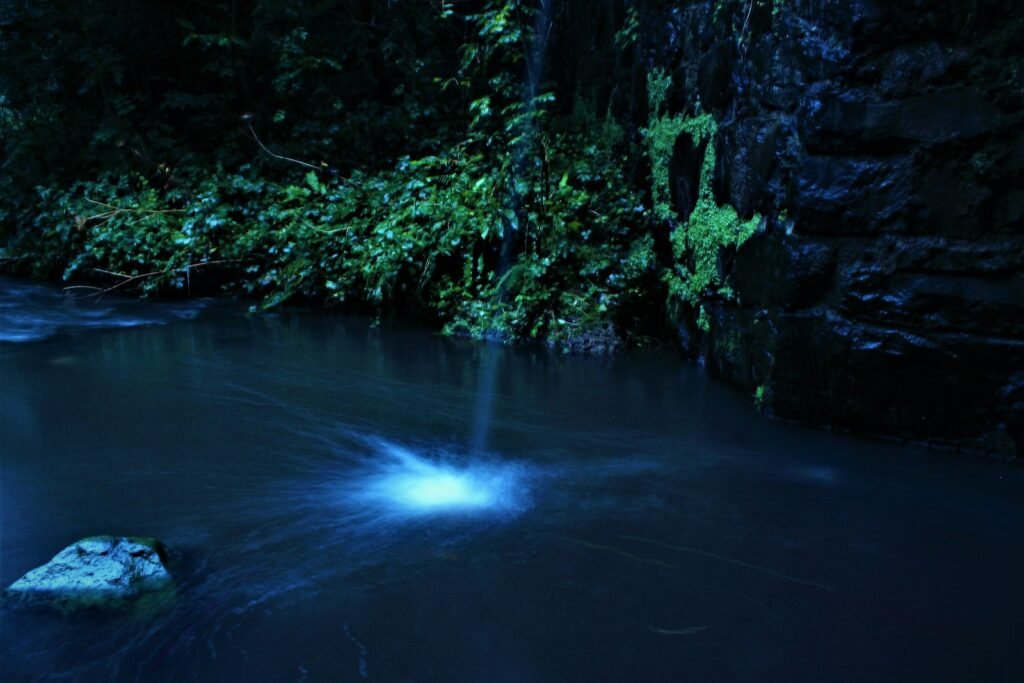
A whopping 76 percent of ocean animals are bioluminescent, which means they produce their own light through a series of chemical reactions or host bacteria that do. The surface displays that capture our attention represent just a tiny fraction of the bioluminescent activity happening throughout the ocean. Bioluminescent organisms live throughout the water column, from the surface to the seafloor, from near the coast to the open ocean. In the deep sea, bioluminescence is extremely common, and because the deep sea is so vast, bioluminescence may be the most common form of communication on the planet! About three-quarters of life in the water column can produce bioluminescence. From jellyfish the size of dinner plates to bacteria invisible to the naked eye, the ocean is filled with living lights creating an underwater aurora that never stops. G. princeps is a bioluminescent species, with both males and females producing blue light. Its light is bright enough that molecular biologists use the bioluminescent pigment as dye in the lab to help them visualize their experiments. The applications of natural




